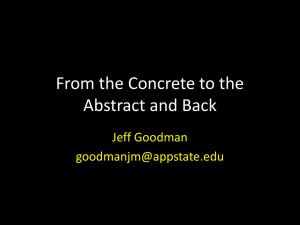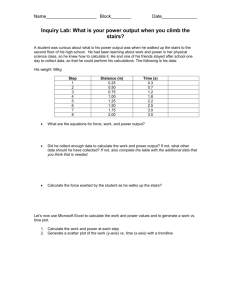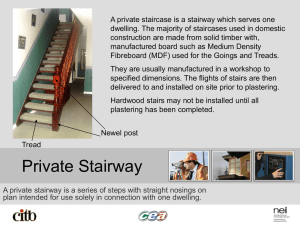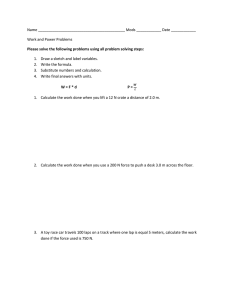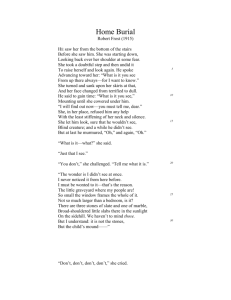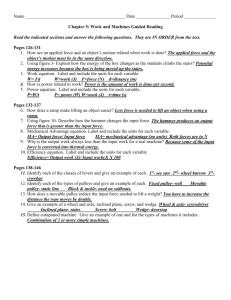LEARNING SEMANTIC MODELS AND GRAMMAR RULES OF BUILDING PARTS {
advertisement
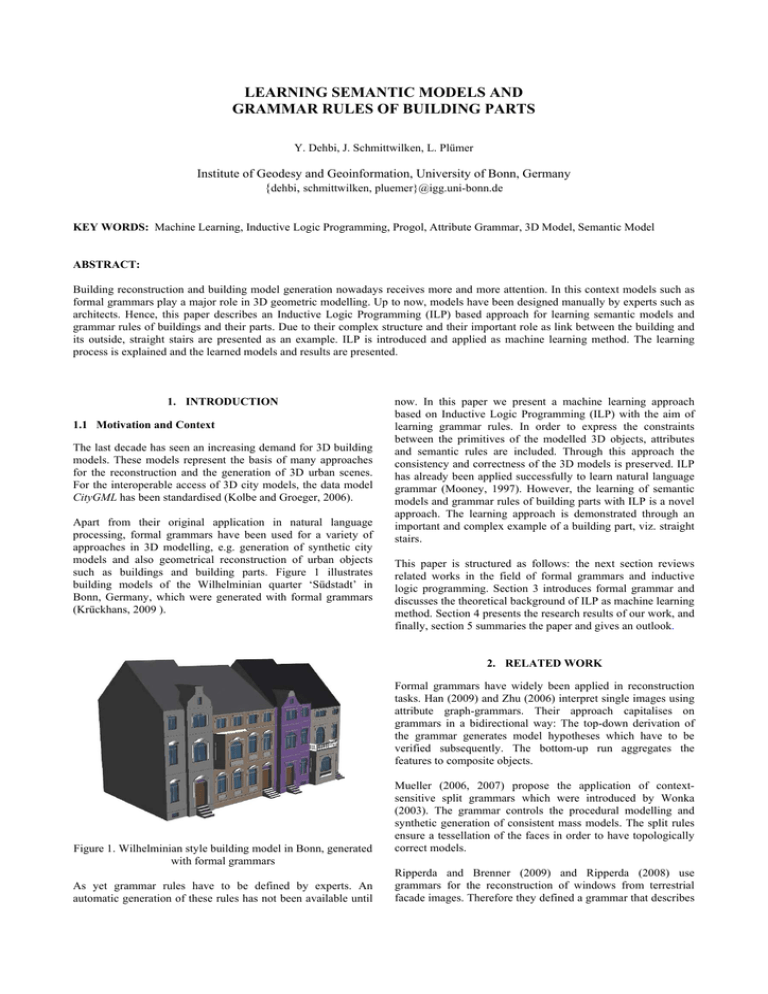
LEARNING SEMANTIC MODELS AND
GRAMMAR RULES OF BUILDING PARTS
Y. Dehbi, J. Schmittwilken, L. Plümer
Institute of Geodesy and Geoinformation, University of Bonn, Germany
{dehbi, schmittwilken, pluemer}@igg.uni-bonn.de
KEY WORDS: Machine Learning, Inductive Logic Programming, Progol, Attribute Grammar, 3D Model, Semantic Model
ABSTRACT:
Building reconstruction and building model generation nowadays receives more and more attention. In this context models such as
formal grammars play a major role in 3D geometric modelling. Up to now, models have been designed manually by experts such as
architects. Hence, this paper describes an Inductive Logic Programming (ILP) based approach for learning semantic models and
grammar rules of buildings and their parts. Due to their complex structure and their important role as link between the building and
its outside, straight stairs are presented as an example. ILP is introduced and applied as machine learning method. The learning
process is explained and the learned models and results are presented.
1. INTRODUCTION
1.1 Motivation and Context
The last decade has seen an increasing demand for 3D building
models. These models represent the basis of many approaches
for the reconstruction and the generation of 3D urban scenes.
For the interoperable access of 3D city models, the data model
CityGML has been standardised (Kolbe and Groeger, 2006).
Apart from their original application in natural language
processing, formal grammars have been used for a variety of
approaches in 3D modelling, e.g. generation of synthetic city
models and also geometrical reconstruction of urban objects
such as buildings and building parts. Figure 1 illustrates
building models of the Wilhelminian quarter ‘Südstadt’ in
Bonn, Germany, which were generated with formal grammars
(Krückhans, 2009 ).
now. In this paper we present a machine learning approach
based on Inductive Logic Programming (ILP) with the aim of
learning grammar rules. In order to express the constraints
between the primitives of the modelled 3D objects, attributes
and semantic rules are included. Through this approach the
consistency and correctness of the 3D models is preserved. ILP
has already been applied successfully to learn natural language
grammar (Mooney, 1997). However, the learning of semantic
models and grammar rules of building parts with ILP is a novel
approach. The learning approach is demonstrated through an
important and complex example of a building part, viz. straight
stairs.
This paper is structured as follows: the next section reviews
related works in the field of formal grammars and inductive
logic programming. Section 3 introduces formal grammar and
discusses the theoretical background of ILP as machine learning
method. Section 4 presents the research results of our work, and
finally, section 5 summaries the paper and gives an outlook.
2. RELATED WORK
Formal grammars have widely been applied in reconstruction
tasks. Han (2009) and Zhu (2006) interpret single images using
attribute graph-grammars. Their approach capitalises on
grammars in a bidirectional way: The top-down derivation of
the grammar generates model hypotheses which have to be
verified subsequently. The bottom-up run aggregates the
features to composite objects.
Figure 1. Wilhelminian style building model in Bonn, generated
with formal grammars
As yet grammar rules have to be defined by experts. An
automatic generation of these rules has not been available until
Mueller (2006, 2007) propose the application of contextsensitive split grammars which were introduced by Wonka
(2003). The grammar controls the procedural modelling and
synthetic generation of consistent mass models. The split rules
ensure a tessellation of the faces in order to have topologically
correct models.
Ripperda and Brenner (2009) and Ripperda (2008) use
grammars for the reconstruction of windows from terrestrial
facade images. Therefore they defined a grammar that describes
the general structure of facades, i.e. the alignment of windows
in grids, both regular and irregular. The grammar controls the
sampling of a reversible jump Markov Chain Monte Carlo
process. Similar to Han (2009) they work on single images.
and back side. Facade is built of windows and Entrance which
is made of doors and stairs. This aggregation can be expressed
by the production rules that are illustrated in the derivation tree
in figure 2.
Schmittwilken (2009) presents an approach for the
reconstruction of composite objects from 3D point clouds using
attribute grammars. The composition is specified by attributes
which define and propagate form parameters and location
parameters of the modelled objects.
Likewise, Building can be represented by the following
production rules P:
Apart from related work in reconstruction context, our approach
draws upon ideas of ILP, which has been successfully applied
as a learning approach in many different fields. In
bioinformatics, for instance, ILP has been used to predict
protein structure (Muggelton et al., 1992) and mutagenicity
(King et al., 1996). Mooney (1997) has applied ILP to natural
language processing.
3. BACKGROUND
In the following section, we will give an introduction to formal
grammars and an overview of the applied machine learning
approach ILP.
3.1 Formal Grammars
Ever since formal grammars were introduced by Chomsky
(1956, 1959) for reconstructing sentences of natural language,
they have also been used to generate formal languages. A
formal grammar G can be defined as quadruple {S, N, T, P} of a
start symbol S, a set of non-terminals N represented by
capitalised initials, a set of terminals T denoted by lower case
initials and a set of production rules P.
A special case of formal grammars are context free grammars
which play a major role in describing and designing most of the
programming languages. Production rules appear in the form
A a where A is a non-terminal, and a is a sequence of
terminals and non-terminals. This rule implies that each
occurrence of the symbol A can be replaced by the string a.
P = {Building Corpus gableRoof
Corpus left Facade right back
Facade Entrance window
Entrance door stairs}
The set of the non-terminals is N = {Building, Corpus, Facade,
Entrance}; the set of terminals is T = {gableRoof, left, right,
back, window, door, stairs}.
Context free grammars are suitable to describe context free
languages. In this case the non-terminals can be substituted
regardless of the context in which they occur. However, some
structures can only be produced with regard to their context. In
the case of stairs, for example, context free grammars are not
expressive enough to state that all steps of the same stairs have
the same dimensions.
P1: Stairsn-1 Step Stairsn
P2: Stairs Step
P3: Step riser tread
R1(P1 ): Stairsn .numberOfSteps = Stairsn-1.numberOfSteps +1
R2(P2): Step.width = Stairs.width
R3(P2): Step.height = Stairs.height
R4(P2): Step.depth = Stairs.depth
…
Table 1. Excerpt of an attribute grammar for stairs
In order to deal with this problem context free grammars have
been extended by Knuth’s attribute grammars (1968, 1971),
which have been further extended by the probabilistic concept
of an attribute grammar as proposed by Abney (1997). In
attribute grammars Terminals and non-terminals are expanded
by attributes, whereas production rules are extended by
semantic rules. The latter specify the constraints among the
attributes. An extract of an attribute grammar of stairs is shown
in Table 1.
Figure 2. Derivation tree for the grammar rules of a building
A gable roof building can be modelled context free as follows:
Building as a start symbol is made of Corpus and gableRoof. In
addition to the Facade, Corpus consists of left side, right side,
Figure 3. Stairs as recursion of steps
In contrast to the first example of the building grammar, stairs
exhibit a recursive structure which allows for specifying an
arbitrary number of steps. A staircase is shown in figure 3 by a
sequence of steps which consist of risers (vertical rectangles)
and treads (horizontal rectangles). The grammar symbols in
table 1. are augmented by the attributes height, depth, and
width, which are used in semantic rules R2(P2) to R4(P2) in order
to specify the identity between the form parameters of risers
and treads within the same stairs. The superscript indices n and
n-1 are used to differentiate between multiple occurrences of
the same symbol.
using snap points or thresholds to obtain consistent learning
examples. This step is beyond the scope of this paper.
Consequently, our focus and attention will be given to ILP as
machine learning formalism.
Another opportunity to handle the uncertainty and to deal with
noisy data consists in the extension of inductive logic
programming techniques with probabilistic reasoning
mechanisms. This area is called Probabilistic Inductive Logic
Programming (Raedt et al., 2008).
3.2 Inductive Logic Programming
Given a set E of positive and negative examples as ground facts
and a background knowledge B, a hypothesis H has to be found
which explains the given examples with respect to B and meets
the language constraints. The hypothesis H has to be complete
and consistent. H is complete if all the positive examples are
covered. If none of the negative examples are covered H is
considered consistent. The coverage of an example e E is
tested with a function covers(B,H, e) which returns the value
true if H covers e given the background knowledge B, and
otherwise returns false.
Inductive Logic Programming is a subarea of artificial
intelligence which combines machine learning with logic
programming. Thus, the goal of ILP, which is inherited from
inductive machine learning, consists in developing techniques
to induce hypotheses from observations as well as synthesising
new knowledge from experience by using computational logic
as representational schema.
In the following section some important concepts in logic
programming are introduced (Raedt, 2008). First, a function is
called predicate, if it returns a truth value, e.g. parallel/2 is a
predicate of arity 2. Second, a term is a constant, a variable or a
structured term f(t1,…,tn) composed of a functor f and n terms ti.
Third, an atom is a predicate symbol followed by its necessary
number of terms, e.g. line(X) is an atom which represents a line
in a two dimensional space and which is represented by the
term X as variable. Fourth, a literal is an atom or its negation.
By using these concepts the key concept of a horn clause can be
defined as an expression of the form: h b1,…,bm in which h
and bi are logical atoms. The symbol ‘,’ symbolises a
conjunction whereas ‘’ stands for an implication. Clauses of
the form: h true are called facts.
An example of a horn clause C can be illustrated by the parallel
relation (here given in the logic programming language
Prolog):
C: parallel(X,Y) line(X), line(Y), line(Z), orthogonal(X,Z),
orthogonal(Y,Z).
Hereby a new predicate parallel is defined as head of the rule
(the arrow’s right hand side being the rule’s body). The line X
and the line Y satisfy this predicate if there is a line Z which is
orthogonal to both lines X and Y. Moreover, a first order
alphabet can be defined as a set of predicate symbols, constant
symbols and functor symbols.
ILP systems are able to learn first order horn clauses by the use
of background knowledge. Apart from syntactic differences,
logic programs and attribute grammar are basically the same
(Abramson and Dahl, 1989). Thus, the learned logic programs
can be safely used for reconstruction tasks realised by attribute
grammars.
The observation of 3D point clouds in order to recognise and
extract constraints (cf. Schmittwilken, 2009) and the learning of
3D models from these constraints are two disjoint but
complementary problems. Thus, this paper assumes that the
user first provides examples such as sketches of the models
which have to be learned. These are then processed either by
3.2.1
Method
The ability to provide declarative background knowledge to the
learning system is one of the most distinct advantages of ILP.
This background knowledge can be given in the form of horn
clauses or ground facts which represent the prior knowledge
about the predicates that appear in the learned hypothesis later.
For example, if instances of the predicates orthogonal and line
(cf. last section) are given, they can serve as background
knowledge in order to learn the parallel relation.
ILP tasks are search problems in the space of possible
hypotheses. In order to perform this search adequately a partial
ordering of clauses is needed. For this purpose many inductive
logic programming systems use θ-subsumption as
generalisation or specialisation operator. A clause C is said to
be θ-subsumed by a clause C’ if there is a substitution θ, such
that C’θ C. Hereby a substitution θ is a function which maps
variables to terms. For instance, the clause:
C’: parallel(X,Y) line(X), line(Y).
θ-subsumes the clause C in the last section under the empty
substitution θ = . The θ-subsumption defines the notion of
generality. A clause C’ is at least as general as clause C if C’
θ-subsumes C (Lavrac, 1994).
3.2.2
Aleph Algorithm
In the last few years many ILP systems have been implemented.
One of the most popular ILP approaches is the Progol
algorithm with many different implementations. Relevant for
this paper is the Aleph engine (cf. Srinivasan, 2007) as a Prolog
based implementation of Progol. Progol is an ILP framework
which was developed to learn first order horn clauses.
For this aim, Progol first selects a positive seed example and
then finds a consistent clause which is the most specific clause
(MSC) of this example and which entails this example. Against
the theoretical background of inverse entailment the MSC can
be acquired (cf. Muggelton, 1995). The construction of the
MSC will be exemplified in section 4.
In this way Progol learns by using a single example and by
verifying the consistency of its generalisation with the dataset.
This generalisation is added to the background knowledge.
Afterwards, all redundant examples which have been covered
by the MSC are removed. This process is repeated until a theory
is found which covers all the positive examples. The coverage
function is defined as follows:
covers(B,H,e) = true if B H ⊨ e
In other words, the hypothesis H covers the example e with
respect to the background knowledge B if B H semantically
entails e.
In order to examine the goodness of clauses, each clause is
evaluated by a score function. In this context, the default
evaluation of Aleph is coverage which defines clause utility as
P-N, in which P, N are the number of positive and negative
examples covered by the considered clause respectively. This
could also be realised by other evaluation functions, like, for
example, entropy.
As mentioned before, ILP tasks are search problems in the
space of possible hypotheses. Progol bounds this space with the
MSC as lower bound, whereas the top of the search space is
bounded by the empty clause. Once the MSC has been built,
Aleph performs a top-down search in the space of possible
specialisations by using θ-subsumption as refinement operator.
In this process only the literals appearing in the MSC are used
to refine clauses.
In order to restrict the vast space of hypotheses, learning
systems employ a so-called declarative bias. “Bias” is anything
other than the training instances that influences the results of
the learner (Raedt, 2008). Aleph makes use of mode
declarations as bias while searching for the best hypothesis. On
the one hand, the mode declarations specify the predicates to be
used, and state whether a predicate is a head (modeh
declaration) or a body (modeb declaration) predicate. On the
other hand, they declare whether an argument of a predicate
may be an input variable, output variable or a constant value.
A further restriction of the space of the possible literals is
achieved by type specification. Hereby a place-marker is
employed in order to constrain the type of the terms that will
replace the place-marker correctly. Aleph treats types just as
labels and does not perform a type-checking. The different
instantiations of a predicate in a given clause with the same
sequence of input variables can also be bound through an
integer, so-called recall number. An asterisk denotes that the
predicate has unbounded indeterminacy. In Aleph, it is possible
to infer mode and type information from the predicates of
generative background knowledge and examples.
The declaration:
modeb(*, orthogonal(+line, -line))
states that the predicate orthogonal has to be used as body
predicate and its arguments have to be instances of the same
type. Additionally, the symbol “+” states that the first argument
is an input argument and therefore it has to be bound, whereas
the second is an output argument and may be either bound or
unbound. In other words, in a literal orthogonal(X, Y), X has to
be an old variable, in contrast to Y that may be either an old or
a new variable. Within a clause any input variable in the body
literal must be an input variable in the head of the clause or an
output variable in some preceding literals.
4. RESULTS
The following section presents the findings of our approach as
well as the problems that have occurred in the process of
learning. The potential to model background knowledge enables
a stepwise learning process of stairs. In order to evaluate the
potential of ILP for the automatic learning of building parts
straight stairs have been used as an example. The specific
challenge in the case of stairs is their recursive structure. At the
beginning it was not clear whether ILP would meet this
challenge. Interestingly, some positive and some negative
examples were sufficient.
Thus, the major difficulty in learning how stairs are defined
consists in handling the recursion. Due to the complexity of
stairs, in particular their recursive structure, the learner requires
a large amount of negative examples. However, the learning
process becomes much easier by applying a modular bottom-up
approach, which consists of two steps: First, the non-recursive
parts of stairs are learned, and then, building up on these parts,
the recursive clause is learned. This divide and conquer
approach is illustrated in figure 4. Stairs are broken down into
their primitives. Aggregation and learning directions are
indicated by descending and ascending arrows respectively.
Aggregation occurs top-down whereas learning is realised by a
bottom-up approach, starting from the smallest atomic feature
to the whole stairs object. The semantic primitives are
marked in bold whereas the topologic primitives are marked in
normal font.
Figure 4. Semantic and topologic primitives of stairs
Table 2 gives the produced output rules of the learner. In order
to learn the end recursive rule in lines (01-05) only four positive
and two negative examples were required. This low number can
be attributed to the stepwise learning strategy. The interested
reader may verify that the difference between these rules and
those in table 1 is merely syntactic. It should be noted that rules
in table 1 are only a subset of the rules of table 2.
On the level of aggregation we have seen in section 3.1 that
stairs are made of a recursion of steps that are composed of
horizontal and vertical rectangles. In turn both rectangles can
be defined by two 3D points. In contrast to the aggregation, the
starting point on the level of learning is two observed left and
01
02
03
04
05
06
07
08
09
10
11
12
13
14
15
16
17
18
stairs([step(R,T,Point,Height,Depth,Width)], Height,Depth,Width).
stairs([step(R2,T2,Point2,Height,Depth,Width),
step(R1,T1,Point1,Height,Depth,Width) | Tail], Height,Depth,Width)
stairs([step(R1,T1,Point1, Height,Depth,Width)| Tail], Height,Depth,Width),
meetsPerpendicular(T1,R2).
step(R,T,Point1,Height,Depth,Width) riser(R,Point1,Height,Width),
tread(T,Point2,Depth,Width),
meetsPerpendicular(R,T).
meetsPerpendicular(R,T) riser(R,Point(X,Y,Z),Height,Width), plus(Z,Height,Z1),
tread(T,Point(X,Y,Z1),Depth,Width).
riser(R,point(X,Y,Z),Height,Width) plus(X,Width,X1), point(X1,Y,Z1), plus(Z,Height,Z1).
tread(T,point(X,Y,Z),Depth,Width) plus(X,Width,X1), point(X1,Y1,Z), plus(Y,Depth,Y1).
meetsPerpendicular(T,R) tread(T,point(X,Y,Z),Depth,Width), plus(Y,Depth,Y1),
riser(R,point(X,Y1,Z),Height,Width).
Table 2. The whole learned logic program of stairs
right 3D points for identifying the horizontal (tread) and the
vertical rectangle (riser) respectively. As described in
subsection 3.2.1, the task of learning requires a set of positive
examples which are generalised with respect to the set of
negative examples and the background knowledge. Aleph
supports first order horn clauses as background knowledge and
is further able to learn ranges and functions with numeric data.
These functions can also be used as background knowledge that
represents a good basis to describe the geometric and topologic
constraints inside building parts. This is particularly important
at the low level of the learning process. Beside the observed
point in the case of riser, the background knowledge
includes arithmetic, namely the operation plus which is used
to specify topologic constraints between these points of the
rectangle and their coplanarity. Since straight stairs are
invariant in rotation we can safely assume an axis-parallelity
with regard to the representation in figure 3.
Altogether two positive examples and two negative examples
were necessary to learn a riser. The learning of the concept of
tread happened analogously. In order to learn a tread the same
number of examples was required. Rules in lines 14 and 16 (cf.
table 2) show the learned rules of riser and tread.
Once riser and tread have been learned, they can be used
as primitives in order to learn the concept of a step. They are
added to the background knowledge. In the following the
learning process will be exemplarily elaborated.
For the completion of the necessary background knowledge of
step, information about the adjacency between risers and treads
is required. This is expressed by the relation
meetsPerpendicular which will be explained later. Now
we are able to learn the concept of step.
The rule in lines (07-09) (cf. table 2) shows the result clause,
which defines a step. The head of this rule represents the whole
step object, whereas the body defines its aggregated
primitives. The attributes R and T serve as an identifier for
riser and tread respectively which the whole step is
composed of. The geometric description of the model is given
by the location and form parameters. The location parameter of
step is described by the attribute Point1. Figure 5
demonstrates that this attribute represents the left point of its
riser. The remaining attributes Height, Depth and Width
constitute the form parameters. For the consistency of the
model the locations as well as the form parameters have to be
propagated, that is, they occur as attributes in the head of the
rule.
The semantic rules are implicitly specified by the identity of the
attributes and the relation meetsPerpendicular. On the
one hand, the identity of the attribute Width in riser and
tread represents the constraint that within the same step the
riser and the tread have the same width. On the other hand, the
occurrence of this attribute in the head ensures its propagation
from the parts to the whole step. In contrast, the values of
Height and Depth are only inherited as property of step
without being further constrained. In addition to the identifier R
and T both the location parameter Point1 and the form
parameters Height, Depth and Width are propagated. We have
already explained that the symbol ‘,’ in the rule must be
interpreted as a logical AND. This rule means that step is a
valid step if a riser and a tread exist which have the same
Width and which are further perpendicularly connected.
As mentioned in section 3.2.2 we demonstrate the construction
of the MSC using an example of step. In order to form a rule for
a step, Aleph searches the subset of the background knowledge
which is relevant for a seed example and conforms to the mode
declarations defined by the user. Table 3. shows an instantiation
of these declarations for the case of step. The target predicate is
declared with the modeh declaration which also specifies the
necessary attributes of a step. The other declarations represent
the possible predicates that may appear in the body of the
learned rule.
modeh(*,step(+riser,+tread,+point,+height,
+depth,+width)).
modeb(*,riser(+riser,+point,+height,+width)).
modeb(*,meetsPerpendicular(+riser,+tread)).
modeb(*,tread(+tread,-point,+depth,+width)).
Table 3. Mode declarations of step
Figure 5: Parameters of a step; 5a, 5b, 5c: Positive examples of a step; 5d, 5e, 5f: Negative examples of a step
At the beginning of the learning process, Aleph picks up a seed
example such as step(r,t,p,1,2,3) provided by the user.
This fact describes that a step is composed of riser r and
tread t with Height = 1, Depth = 2 and Width = 3
respectively. We assume that the following facts are available
in the background knowledge: riser(r,p,1,3),
tread(t,p’,2,3) and meetsPerpendicular(r,t).
In this case the identity of the constants r and 3 in step and
riser is decisive to specify how relevant the fact
riser(r,p,1,3) is for step(r,t,1,2,3). In the same
manner the remaining facts will be considered as relevant.
Consequently the following rule is formed from these facts:
step(r,t,p,1,2,3) riser(r,p,1,3), tread(t,p’,2,3),
meetsPerpendicular(r,t).
Now this rule is generalised to the following clause which
meets the mode declarations presented in table 3.:
step(R,T,P,Height,Depth,Width) riser(R,P,Height,Width),
tread(T,P’,Depth,Width), meetsPerpendicular(R,T).
The relation meetsPerpendicular in Table 2 ensures the
topological correctness of the step model. A 3D model is said to
be topologically correct if only meets and disjoint are allowed
as spatial relations between its different objects (Egenhofer and
Franzosa, 1991), viz, that geometric objects do not intersect or
cover one another. This is assured by the arithmetic operation
plus which moves the left point of riser by the distance
Height along the z-axis. The perpendicularity is ensured by the
vertical and horizontal alignment of riser and tread respectively.
In order to understand how the examples influence the learning,
an excerpt of positive and negative examples which has been
used to learn a step is illustrated in figure 5. The first three
examples are positive examples, whereas the last three are
negative examples. The examples 5a, 5b and 5c represent
correct steps in which riser and tread have various Depth and
Height and are perpendicular connected to build a step with a
mutual edge. The example 5d avoids that a tread and a riser are
validated to a step although they do not meet. Example 5e
cannot represent a step because the constraint enforcing the
movement of the left point of the riser along the z-axis is not
satisfied. The last example 5f illustrates the case that the riser
meets perpendicularly with another geometric object which
does not correspond to a tread. All in all three positive and three
negative examples were needed to learn the rule of step.
The concept of steps is only one part of the concept of stairs.
The adjacency between steps has to be learned as well. In
contrast to the relation meetsPerpendicular in line 11
which ensures the topologic correctness within a step the
relation meetsPerpendicular in line 18 ensures this
correctness between two neighbouring steps within stairs.
Now we have the necessary background knowledge to learn the
recursive concept of stairs. The rule for stairs has already
been shown in table 2 (cf. lines 01-05). The square brackets in
this rule symbolise a list in Prolog. In other words, stairs are
represented as a list of steps which is separated into head and
tail (stairs([head|tail])). The new stairs on the left side of
the rule consists of the stairs from the right side
concatenated with the next new neighbouring step. As
mentioned above, the neighbourhood of the steps is ensured
with the meetsPerpendicular relation. This concatenation
of steps implies that the new stairs consists of exactly one
step more than the one before. Once again it should be noted
that four positive examples and two negative examples were
sufficient to learn the recursive clause stairs.
Aleph is one of the so-called batch learners. This means that the
examples which are labelled positive or negative have to be
provided before the learning process takes place, in contrast to
incremental learners which expect that the examples will be
given step by step. In this context the positive and the negative
examples of the concept to be learned are written in two
separate files. The background knowledge is delivered
additionally in a third file which contains clauses and facts that
represent logically encoded information relevant to the domain
of interest.
Furthermore, the validity of the generalised models has to be
verified by a user. Thus, Aleph belongs to the category of
interactive systems. Since attribute grammar rules are
generative, the user is able to test and adjust the temporary
results and classify new examples until a valid model of the
target concept has been generated.
5. SUMMARY AND OUTLOOK
We have introduced an ILP based approach for learning
semantic models and grammar rules of building parts and have
taken straight stairs as an example to demonstrate our machine
learning approach. Beside the geometric and the topological
constraints, the specific challenge lies in handling the complex
recursive structure. This complexity has been overcome by
using a bottom-up approach consisting in learning nonrecursive primitives of stairs first, and then learning the whole
stairs.
The ability to corporate background knowledge turns out to be a
major tool to cope with this kind of complexity. The learned
model is correct and consistent from a geometrical, topological
and semantic point of view. A very limited number of examples
were sufficient to explain a human understanding of stairs to the
machine.
Recursion did not turn out to be a major obstacle.
Consequently, this is the first step of a major project for an
interactive generating of semantic models and attribute
grammar rules of man-made objects such as buildings.
This paper proposed a machine learning method for 3D models
which requires examples provided by the user. Another
possibility is to learn such models by taking into consideration
observed noisy data. In order to deal with these uncertainties
and deviations, our future works will include probabilistic logic
models in the learning process.
Mitchell, T.M., 1997. Machine Learning. McGraw-Hill, New
York
Mooney, R.J. 1997. Inductive Logic Programming for Natural
Language Processing. In: (eds): In Muggleton, S. (Ed.),
Inductive Logic Programming: Selected papers from the 6th
International Workshop. Springer-Verlag, pp 3‐24
Muggleton, S., King, R.D. , Sternberg, M.J.E. 1992. Protein
secondary structure prediction using logic. In:. Muggleton S
(eds): ILP92, pp 228-259
Muggleton, S., 1995. Inverse Entailment and Progol. New
Generation Computing, Special issue on Inductive Logic
Programming, pp. 245‐286
Muggleton, S., Raedt, L. de, 1994. Inductive Logic
Programming: Theory and Methods. Journal of Logic
Programming, pp. 629‐679
6. REFERENCES
Abney, S., 1997. Stochastic Attribute-Value Grammars.
Computational Linguistics, 4, pp. 597‐618
Abramson, H., Dahl, V., 1989. Logic grammars. Springer, New
York
Chomsky, N., 1956. Three models for the description of
language. Information Theory, IEEE Transactions, 3, pp.
113‐124
Chomsky, N., 1959. On Certain Formal Properties of
Grammars. Information and Control, pp. 137-167
Egenhofer, M., Franzosa, R.D., 1991. Point-Set Topological
Spatial Relations. International Journal of Geographical
Information Systems, 2, pp. 161-174
Kolbe, T.H., Gröger, G., Czerwinski, A. 2006. City Geography
Markup Language (CityGML), Implementation Specification
Version 0.3.0, Discussion Paper, OGC Doc. No. 06-057. Open
Geospatial Consortium
Müller, P., Wonka, P., Haegler, S. , van Ulmer, A.a.G.L., 2006.
Procedural Modeling of Buildings. ACM Transactions on
Graphics, 3, pp. 614‐623
Müller, P., Zeng, G., Wonka, P. , van Gool, L. 2007. Imagebased Procedural Modeling of Facades. In: (eds): Proceedings
of ACM SIGGRAPH 2007 / ACM Transactions on Graphics.
ACM Press, New York, NY, USA, p 85
Raedt, L. De, 2008. Logical and relational learning: With 10
tables. Springer, Berlin
Raedt, L. De, Frasconi, P., Kersting, K., Muggleton, S.H.
(Eds.), 2008. Probabilistic inductive logic programming:
Theory and applications ; [result of European IST FET project
no. FP6-508861 on application of probabilistic inductive logic
programming (APRIL II, 2004-2007)]. Springer, Berlin
Srinivasan, A., 2007. The Aleph Manual Version 4 and above.
http://www.comlab.ox.ac.uk/activities/machinelearning/Aleph/a
leph_toc.html (accessed 30 October 2009)
Han, F., Zhu, S.-C., 2009. Bottom-Up/Top-Down Image
Parsing with Attribute Grammar. IEEE Transactions on Pattern
Analysis and Machine Intelligence, 1, pp. 59-73
Ripperda, N., 2008. Grammar Based Facade Reconstruction
using
RjMCMC.
Photogrammetrie,
Fernerkundung,
Geoinformation, pp. 83‐92
King, R. D., Muggleton, S., Srinivasan, A., Sternberg, M. J. E.
1996. Representing molecular structure activity relationships:
the use of atoms and their bond connectivities to predict
mutagenicity using inductive logic programming. Proc. Nat.
Acad. Sci. USA, 1993, 438-442.
Ripperda, N., Brenner, C. 2009. Application of a Formal
Grammar to Facade Reconstruction in Semiautomatic and
Automatic Environments. In: (eds): Proc. of 12th AGILE
Conference on GISience
Knuth, D.E., 1968. Semantics of context-free languages. Theory
of Computing Systems, 2, pp. 127‐145
Schmittwilken, J., Plümer, L. 2009. Model Selection for
Composite Objects with Attribute Grammars. In: (eds): Proc. of
12th AGILE Conference on GIScience
Knuth, D.E., 1971. Top-down
Informatica, 2, pp. 79-110
Syntax
Analysis.
Acta
Krückhans, M., Schmittwilken, J. 2009. Synthetische
Verfeinerung von 3D-Stadtmodellen. In: (eds): Proceedings of
DGPF-Jahrestagung,
March
2009,
Jena,
Germany
(Translation: Synthetic Refinement of 3D City Models)
Lavrac, N., Dzeroski, S., 1994. Inductive logic programming:
Techniques and applications. Horwood, New York
Wonka, P., Wimmer, M., Sillion, F. , Ribarsky, W., 2003.
Instant Architecture. ACM Transactions on Graphics, 4, pp.
669-677
Zhu, S.-C., Mumford, D., 2006. A Stochastic Grammar of
Images. Foundations and Trends in Computer Graphics and
Vision, pp. 259‐362

